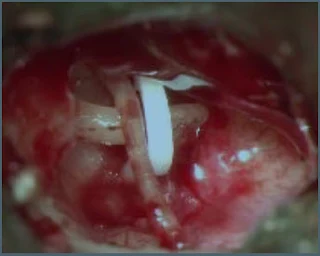What is Otosclerosis?
Localized hereditary disorder affecting endochondrial bone of the otic capsule, characterized by disordered bone resorption and deposition, leading to replacement of normal compact lamellar bone by abnormal spongy bone of greater thickness, cellularity & vascularity with progressive fixation of stapes.
Causes of Otosclerosis:
1- Genetic predisposition: most common among white people, uncommon among Asians, and extremely rare in black people. Estimated to occur histologically in 10% of white population, and resulted in conductive hearing loss in 1%. It is twice as common in females as in males.
- Most studies support a pattern of autosomal dominant transmission with incomplete penetrance.
- There is evidence to suggest that some cases may be related to defects in expression of the COL1A1 gene.
2- Measles.
3- Autoimmune disease: with humoral autoimmunity to type II collagen.
4- Biochemical abnormalities: reactivation of the arrested secondary remodeling process within the cartilaginous rest areas of the otic capsule.
Predisposing factors:
a- Hereditary tendency: +ve family history in 50%.
b- Endocrinal:increased by thyrotoxicosis & puberty.
c- Pregnancy: accelerates the process.
Incidence of Otosclerosis:
It is race dependent and within a race the incidence is likely to be related to gender and age.
- Onset: 15 – 45 y. Female = male 2/1.
- It is the commonest cause of bilateral conductive deafness (C.D) in adults.
- Usually bilateral, but unilateral in 10%.
- The incidence of histological otosclerosis in unselected temporal bones is in the range of 3.5%.
- The incidence of presumptive clinical otosclerosis in the adult UK population is 2%.
Pathology :
Replacement of normal compact lamellar bone by abnormal spongy bone of greater thickness, cellularity & vascularity with progressive fixation of stapes.
Sites: Anterior margin of oval window (fissula antefenstam) 85% of cases. Fissula post fenstram >> Round window >> cochlear capsule.
Types of Otosclerosis:
A: Stapedial Conductive hearing loss (commonest).
B: Pure cochlear: affection of endosteal layer of labyrinth >> SNHL (rare).
C: Mixed: mixed hearing loss.
Symptoms of Otosclerosis:
1- Deafness: bilateral, progressive.
2- Tinnitus.
3- Paracusis willsii: hearing better in noisy places due to rising of friend’s voice.
Signs of Otosclerosis:
- Quiet voice.
- Intact normal T.M, in active otosclerosis dilated B.V on promontory produce flamingo red tinge (schwartze sign).
- Tunning fork: bilateral C.D variable degree (rarely SNHL or mixed).
Investigations to confirm diagnosis:
- PTA: - In stapedial otosclerosis: Bilateral symmetrical C.D.
- In cochlear type: SNHL
- In mixed type: Mixed deafness
-Tympanometry: type As.
2-Radiology: CT shows otosclerotic foci.
Treatmen of Otosclerosis:
(A) No ttt: in mild cases AB gap < 20dB.
(B) Surgical ttt: stapedectomy: ttt of choice, done for worse ear 1st.
(C) Hearing aid. Good alternative to surgery if operation is contraindicated, refused,or failed.
(D)Medical ttt: Sodium fluoride therapy.
Indication: Progressive SNHL.
Action: Causes maturation of the active otosclerotic foci.
Dose: 30mg enteric coated tab T.D.S. after meals up to 2 y with ca & vit.D.
Contraindication: pregnancy, young age, renal dysfunction, rheumatoid.
Key points
- The incidence is declining.
- It’s either: stapedial, cochlear or mixed. It starts as unilateral disease however bilateral affection is not uncommon.
- Treatment is either by observation and regular follow up, hearing aid, medical with floride medications or surgical with stapedectomy or stapedotomy.
- The stapedial type is the most common type and it’s a very common cause for conductive hearing loss with intact normal tympanic membrane.

